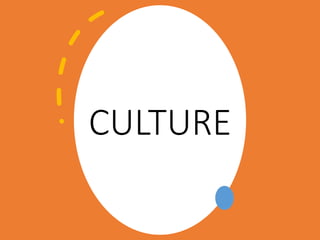
Understanding Culture in Anthropological and Sociological Perspectives
- 1. CULTURE
- 2. Culture (in an Anthropological Perspective) •Is a complex whole which encompasses beliefs, practices, values, attitudes, laws norms, artefacts, symbols, knowledge, and everything that a person learns and shares as a member of society (E.B. Tylor) ENCULTURATION: •A diffusion of one’s culture to another through diverse means, namely learning, imposition by force, and conquest, among others.
- 3. Enculturation leads to: •Identity formation -the formation of the identity of an individual through his interaction with other people. ex. Chinese foods and traditions. Korean language and culture
- 4. Elements of Culture • Beliefs- the conceptions and ideas of man regarding his environment. • Symbols- anything that has meaning and represents something else (Kendall, 2013) • Language- a set of symbols that expresses ideas which enables people to formulate thoughts and communicate with one another. •Values- a sum of all ideas and concepts that is desirable in a particular culture. •Norms- a concrete set of rules and standards to be observed by man in his cultural setting. •Law- a rule or policy that governs the conduct of men which is mostly enacted by a sovereign power
- 5. •Norms -are culturally determined rules that guide people regarding what’s right, wrong proper, or improper. -It creates predictability in daily affairs and interactions, making it easier to live with other members of society. ex. Wearing decent clothes for specific events or occasions. - not laughing when someone commits mistake.
- 6. •Values: -Are experimented by a particular society to check its relevance and appropriateness to existing norms and laws. -Are created and shaped in the community through time. •Status -is any position that an individual can occupy in society. It is not a ranked position, but simply label that implies certain roles that must be performed. Ex. Being a singer, a student, and an artist at the same time.
- 7. 2 Types of Status •1. Ascribed: it is given at birth, or assigned later in life. •Ex. Age, sex, ethnicity, and membership in a family. •2. Achieved: It is acquired willfully and consciously through effort, talent, decisions, and accomplishments. •Ex. Being someone’s girlfriend /boyfriend, being a top student, etc.
- 8. Aspects of Culture •Culture is Learned -Enculturation- the process of learning the accepted norms and values of the culture or society where the individual lives. •Culture is Shared- it is not something that an individual alone can possess. •Culture is Cumulative- based on the knowledge and understanding gained from specific experiences.
- 9. Aspects of Culture •Culture is Dynamic- It exists as a continuous process •Culture is Diverse- It varies from society to society. •Culture is Communicated- it is communicated from one generation to another through language.
- 10. Would You Rather
- 15. Culture (in a Sociological Perspective) 1. Mainstream Culture •Includes the cultural patterns that are broadly in line with a society’s cultural ideas and values. a. Low Culture (Pop Culture) - includes the cultural behaviors and ideas that are popular with most people in a society. b. High Culture - refers to cultural patterns that distinguish a society’s elite.
- 16. Culture (in a Sociological Perspective) 2. Subculture: Refers to the cultural patterns that set apart a segment of a society’s population. 3. Counter-culture: pushes back on mainstream culture in an attempt to change how society functions. -ex. Feminism, LGBTQI Rights
- 17. Question: Who decides what’s mainstream, and what’s a sub- culture?
- 18. Who decides what’s mainstream, and what’s a sub-culture? •Norm: Cultural groups with the most power and societal influence. •Subgroups: people with less power.
- 19. Culture as a Social Perspective •Ethnocentrism -seeing one culture as superior than the other. -the practice of judging one culture by the standards of another. a. It encourages the solidarity of a group in a negative way. b. It hinders the understanding or the cooperation between groups. c. It leads to cultural conflict.
- 20. Culture as a Social Perspective •Xenocentrism- It is characterized by a strong belief that one’s own culture (products, style, or ideas) is inferior to those which originate elsewhere. Ex. Filipino’s preference for imported goods because anything abroad is better (Balikbayan Box).
- 21. Culture as a Social Perspective •Xenophobia- It is the fear of what is perceived as foreign or strange. It may include: a. The fear of losing identity b. Suspicion of the other group’s activities c. Aggression d. The desire to eliminate the presence of the other group to secure a presumed purity.
- 22. Culture as a Social Perspective •Multiculturalism (Cultural Relativism) -recognizes cultural diversity while advocating for equal standing for all cultural traditions. Appreciation of other cultures may come from two reasons: a. Acquisition of sufficient knowledge about other culture. b. Direct exposure to other cultures
- 23. Links for References: • https://www2.palomar.edu/anthro/culture/culture_1.htm • https://www.khanacademy.org/test-prep/mcat/society-and- culture/culture/a/cultural-relativism-article • https://www.cliffsnotes.com/study-guides/sociology/culture-and- societies/culture-and-society-defined